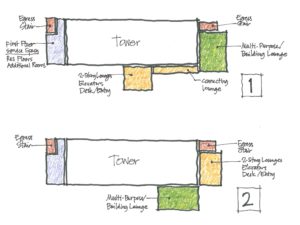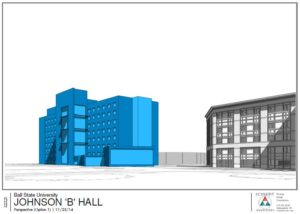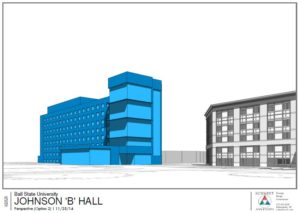Iterations and Evolutions
-
Category
Innovation -
Posted By
Steve Alspaugh -
Posted On
Jan 20, 2017
Design discovery is a process, not an event. It involves developmental steps which consider and refine more and more information as it moves towards becoming a reality. It is not always a linear process, sometimes turning back on itself to reconsider a previous direction and chart a new one. The path of a design process may different for different people, but a clear understanding of the problem is always necessary if you intend to solve the right problem.
We explore our design challenges in iterative steps, benefiting from new or previous investigations of multiple approaches or ideas which may be wholly different one from another.


Ball State University Schmidt/Wilson Residence Hall layout options
Often, the final solution may combine the best aspects of one central idea with interesting nuggets mined from other explorations to create something more dynamic and beneficial than the original idea.


Option 1 rendering


Option 2 rendering
We don’t take our role as designers of the spaces our clients will live and work in every day lightly. We direct our energy as if we are designing these spaces for ourselves.
Similarly, a successful design outcome relies on appropriate responses to good, honest feedback from the design team, but especially from the project’s stakeholders. This feedback comes to us in the form of a never-ending loop in the process as stakeholders respond to the different iterations, allowing our team to make modifications. This improves the function, character, and connectivity of the building and its spaces.
In our digitally-interactive age, Schmidt Associates has evolved the acquisition of feedback to an entirely new level with our project blogs. Most of our K-12 clients (about 20 different projects at this point) see the design iterations for specific portions of their project coming to them electronically. They are complete with graphics and explanatory text, allowing them to simultaneously share their responses with other stakeholders and the design team to affirm or redirect the progress more quickly. This type of feedback loop works within, but does not replace, the design dialogues from face-to-face or web meetings. It accelerates and augments the conversations to achieve a more complete solution more quickly.
Design is a funny word. Some people think design means how it looks. But of course, if you dig deeper, it’s really how it works.
– Steve Jobs




